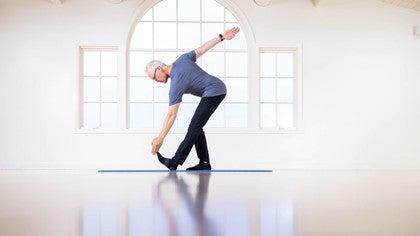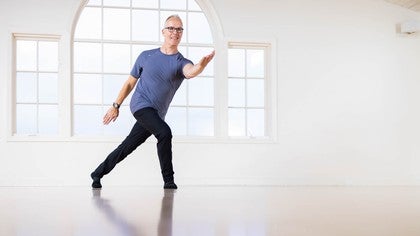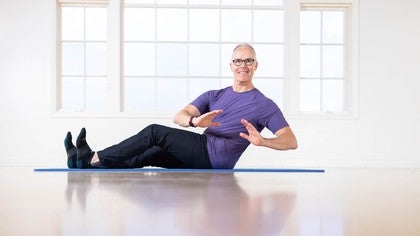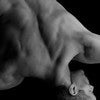Description
About This Video
Transcript
Read Full Transcript
Hi, everybody. I'm gonna give you some really useful information about the foot and then you can tie it into a great exercise you can do daily to improve balance and resilience and intelligence in the legs and feet in relationship to gravity. So in terms of when we're standing on our feet, the three key weight bearings of the foot that you wanna learn to stand on regularly in an even way are number one, your heel. Number two, the ball behind your big toe. Number three, the ball behind your little toe.
So we call those that your tripod of your foot. And so being on those three, even though you're staying on those three, the foot changes shape when you bend and straighten your legs. So even though you're gonna keep those three, as you bend your legs, you can see how the foot lengthens and flattens. It widens and lengthens. Then it domes back up as you straighten 'cause the foot's a mobile adapter that absorbs and transfers force just like the bottom of your pelvis, your muscles, your spine.
They all do this to a degree to absorb and transfer force three dimensionally. So you wanna be able to keep those three foot points 'cause in reality, a lot of times people say, "I have unstable ankles" but really what tends to be the more relevant or accurate is they have unstable foot points. So we're gonna do just a couple exercises that'll help you with that. So I'll put the foot out of the way. So when you look down at your feet with your feet maybe six inches apart and parallel, look at your feet and lift your 10 toes so you can feel your three foot points.
Now, you'll notice that say my feet are more towards pronation, which means more caved to the middle, if I lift my toes and my ankle changes to get my three foot points, that's telling me that my foot is starting in a pronated position. So I wanna learn to practice, as I lift my toes, feeling that neutral alignment and starting to practice that more often when I stand. So just that awareness will help you stand better on your legs, which helps your feet, your spine and your whole body be more aligned in gravity. And I'm able to keep those three foot points on the floor. So feel the three.
Keep the three. Now, we're gonna go through what's called the clock step where we slide one leg forward to the numbers around the clock. We'll go from one to eight on one side, then from 12 to four on the other side. The key thing you're doing when you're doing the exercise though is keep all the weight on the standing leg. You're not shifting onto the moving leg.
So we'll bring the hands to the hips. I'm gonna shift onto this leg on this side. This would be your left leg, your right leg. Now, as you slide the other foot forward, keep the three foot points on the floor, slide it out to 12, then come right back up. Now slide it to one.
Focus on your three foot points on your standing leg. Come back up. Now slide it to two. Come back up, slide it to three. Feel your three foot points. Come back up.
Now, as you slide it to four, let the pelvis turn but keep your three foot points and even let the knee come in slightly but don't lose your foot points. Come back up, slide it to five. It's okay for the knee to move. Back up, now slide back to six. Keep your head straight ahead, back up.
Now, as you reach across the back, reach the same side arm forward as a counter. So now you're gonna load your hips, hard to talk and do. (Tim chuckling) Bring it back up. Then across to eight. (Tim exhaling) And back up.
So that's one round. Now we're gonna do the second side. I recommend you do like two when you practice on your own, slide and bend. Press into the foot points. Feel the foot, the arch lifts as you're coming back in.
It lengthens as you slide. (Tim exhaling) Stay vertical, 10 o'clock or 2, three or nine. As you turn back to four or eight, let the knee move but keep the three foot points on the floor. (Tim exhaling) Back to seven or five, into the floor to come up. You're feeling how you're activating all your leg muscles.
Back to six. (Tim exhaling) As you reach across the back, reach the same side arm forward, press into the ground to come back up. One more time across and back up. And then sense your alignment, sense your foot points. So by challenging your base of support in all these different ranges, you're making your body smarter, improving your balance.
You can do this regularly. Thank you. Hope you enjoyed and hope to see you again soon.
Empowered Aging: Moving Well
Comments
Tom
You need to be a subscriber to post a comment.
Please Log In or Create an Account to start your free trial.














